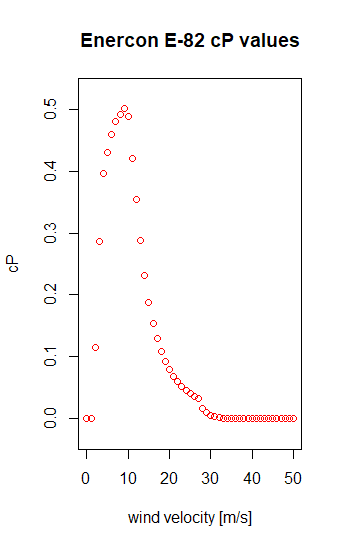Wind Energy Converter Model
This page describes the wind energy converter model (WecModel). Given the current wind velocity, temperature and air pressure the model can calculate the wind turbines active power output.
Attributes, Units and Remarks
Please refer to PowerSystemDataModel - Wec Model or Attributes and Units used in this Model.
Calculation
The figure below depicts the calculation steps as implemented.

Air density The air density is calculated using the temperature and the air pressure, as stated in the diagram above. For this calculation the formula $\rho = \frac{(P \cdot M)}{R \cdot T}$ is used. The arguments for this formula are listed in the table below. In case no air pressure is given, the default value $1.2401 \frac{kg}{m^3}$ is returned, which corresponds to the air density at sea level at 20° Celsius.
Argument |
Unit |
Remarks |
|---|---|---|
P |
Pa |
air pressure |
M |
kg/mol |
molar mass of air (0.0289647) |
R |
J/(mol*K) |
universal gas constant (8.3144626181532) |
T |
K |
temperature |
Note, that the arguments M and R are constants. Their values are contained in the column “Remarks”. After inserting the constant values the formula looks as follows: $\rho = \frac{p}{287.058 \cdot T}$
Enercon E-82
It is useful to look at a real wind turbine for the visualization of some parameters.
Rotor area
The Enercon E-82 has a three-bladed rotor with a diameter of 82m. A rotors swept area is a circle, therefore it is calculated as follows: $A = \pi \cdot r^2$. The swept area (rotorArea) of the Enercon E-82 is $5281.02:{m^2} = \pi \cdot (\frac{82:m}{2})^2$.
Betz curve
The betz curve (or betz characteristic) is a mapping of wind velocities to cP values. It is used to determine the power that can be extracted from the wind. It follows Betz’s law. Each wind turbine has a unique betz curve. The figure below shows the betz curve for the Enercon E-82 wind turbine.

The cut-in wind velocity is $2\frac{m}{s}$, meaning that the turbine requires wind speed of at least $2\frac{m}{s}$ to produce energy. The cut-off wind velocity is $34\frac{m}{s}$, meaning that the Enercon E-82 won’t produce energy for velocities that are higher.